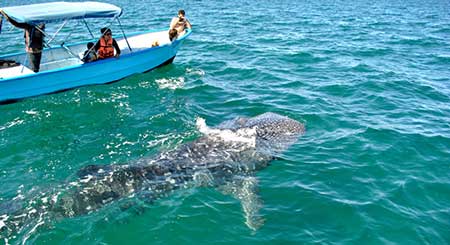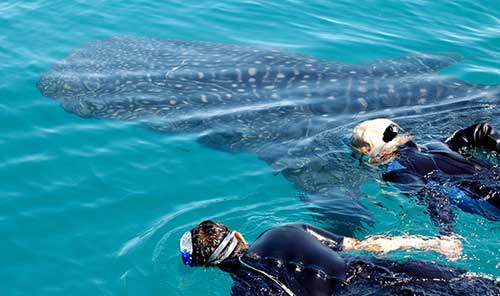
The
Whale Sharks
of La Paz
The whale shark, while not a whale, is definitely a shark which is a fish. Whale sharks are the largest fish in the world growing up to 40 feet long and weighing up to 47,000 pounds. Although massive, these gentle marine giants are not dangerous to divers, snorkelers and swimmers and eat only tiny plankton and krill. Their enormous mouths (nearly five feet wide) engulf large quantities of the tiny plants and animals along with any small fish that happen to be around. This plankton is filtered through their gills as they swim close to the water's surface.
The whale shark has a flattened head and a blunt snout above its mouth with short whiskers (barbels) protruding from its nostrils. Its back and sides are gray to brown with white spots among pale vertical and horizontal stripes, and its belly is white. Its two dorsal fins are set rearward on its body, which ends in a large dual-lobbed tail. Every whale shark has a unique pattern of spots and stripes on their skin, and scientists use them to identify individual sharks. In La Paz we have mostly juvenile whale sharks that gather here to seek shelter and feed. They tend to leave once they become sexually mature.

Whale sharks are recognized under Mexican law as a threatened species. To protect these vulnerable creatures the whale shark areas are restricted to licensed tour operators. These captains are trained in the proper way to approach the animals, the correct swimming distance and the maximum number of pangas and people around each individual whale shark. To find a tour operator consult the Club Cruceros Service Directory under Diving – Charters, Tours & Certification. Non commercial visitors on private yachts and in small dinghys are liable to steep fines if they enter the whale shark areas. The whale sharks are usually found near the middle of the spit of land out in front of the Magote. Currents in the area form a rich upwelling that provides food for the sharks.

Whale Shark Mexico
Whale Shark Mexico has maintained a whale shark monitoring program in La Paz since 2003. Unfortunately at that time their data showed that up to 66% of juveniles had been hit by boats. In collaboration with the Mexican government, a Code of Conduct was generated for whale shark tour operators. Tour operators are now educated and licensed. From 2009 - 2012 careful monitoring of the whale shark population revealed that the injured sharks decreased by 26%. Visit their website at www.whalesharkmexico.com for more information on the whale shark conservation efforts of this group and how you can do your part to protect this vulnerable species in the Sea of Cortez.

If you wish to get in the water with the fish it can be an unforgettable experience. The waters of the Sea are relatively cold in the winter so even with a wet-suit you may be cold. Stay clear and give the giant at least 6 feet of space. You shouldn't touch the shark or ride it, if you simply swim alongside you show total respect and make the encounter even more powerful. Respect is the most important thing when you interact with animals. Touching a whale shark's skin can leave them open to life threatening infection. With the fish moving so slowly and docilely, it is difficult to resist the urge to get close but remember this is a large animal moving freely in the wild. A brisk movement of the tail to escape intruders can cause injury to swimmers. It is a breath taking experience to look eye to eye with a creature this large.
There are many ways you can help global whale shark conservation. One of the most important ways is by respecting and keeping our oceans clean. If you happen to see a whale shark while out cruising take photos of the sides of the sharks, which can be used to identify individuals using the unique spot patterns. Send your photos and record your information at the global library Wildbook for Whale Sharks.